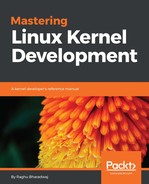Modern operating systems not only prevent one process from accessing another but also prevent processes from accidentally accessing or manipulating kernel data and services (as the kernel is shared by all the processes).
Operating systems achieve this protection by segmenting the whole memory into two logical halves, the user and kernel space. This bifurcation ensures that all processes that are assigned address spaces are mapped to the user space section of memory and kernel data and services run in kernel space. The kernel achieves this protection in coordination with the hardware. While an application process is executing instructions from its code segment, the CPU is operating in user mode. When a process intends to invoke a kernel service, it needs to switch the CPU into privileged mode (kernel mode), which is achieved through special functions called APIs (application programming interfaces). These APIs enable user processes to switch into the kernel space using special CPU instructions and then execute the required services through system calls. On completion of the requested service, the kernel executes another mode switch, this time back from kernel mode to user mode, using another set of CPU instructions.
The following figure depicts a virtualized memory view:

